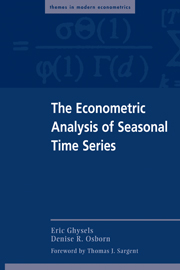Book contents
- Frontmatter
- Contents
- Foreword by Thomas J. Sargent
- Preface
- List of Symbols and Notations
- 1 Introduction to Seasonal Processes
- 2 Deterministic Seasonality
- 3 Seasonal Unit Root Processes
- 4 Seasonal Adjustment Programs
- 5 Estimation and Hypothesis Testing with Unfiltered and Filtered Data
- 6 Periodic Processes
- 7 Some Nonlinear Seasonal Models
- Epilogue
- Bibliography
- Subject Index
- Author Index
2 - Deterministic Seasonality
Published online by Cambridge University Press: 05 June 2012
- Frontmatter
- Contents
- Foreword by Thomas J. Sargent
- Preface
- List of Symbols and Notations
- 1 Introduction to Seasonal Processes
- 2 Deterministic Seasonality
- 3 Seasonal Unit Root Processes
- 4 Seasonal Adjustment Programs
- 5 Estimation and Hypothesis Testing with Unfiltered and Filtered Data
- 6 Periodic Processes
- 7 Some Nonlinear Seasonal Models
- Epilogue
- Bibliography
- Subject Index
- Author Index
Summary
Introduction
Chapter 1 has given an overview of various types of seasonal processes. This chapter looks at deterministic seasonality in more detail, commencing in Section 2.2 with the dummy variable and trigonometric representations. It is, however, impossible to consider recent developments concerned with deterministic seasonality in isolation from issues surrounding stochastic, and particularly nonstationary stochastic, seasonality. Therefore, our discussion continues in Section 2.3 with a further analysis and comparison between these processes introduced in Chapter 1. The final part of this chapter, Section 2.4, discusses recently proposed tests designed to distinguish between deterministic and nonstationary stochastic seasonality by testing the null hypothesis that seasonality is of the deterministic type. The issue of deterministic versus nonstationary stochastic seasonality reemerges in Chapter 3, where the nonstationary null hypothesis is examined. Thus, the analysis of much of the present chapter and that of Chapter 3 can be seen as complementary.
Some notation will assist in our discussion. When issues related to seasonality are considered, it is often convenient to recognize explicitly the season and the year to which a specific observation t relates. This is conveniently achieved by using two subscripts for a variable as in Section 1.3, with the first subscript referring to the season and the second to the year.
- Type
- Chapter
- Information
- The Econometric Analysis of Seasonal Time Series , pp. 19 - 41Publisher: Cambridge University PressPrint publication year: 2001

